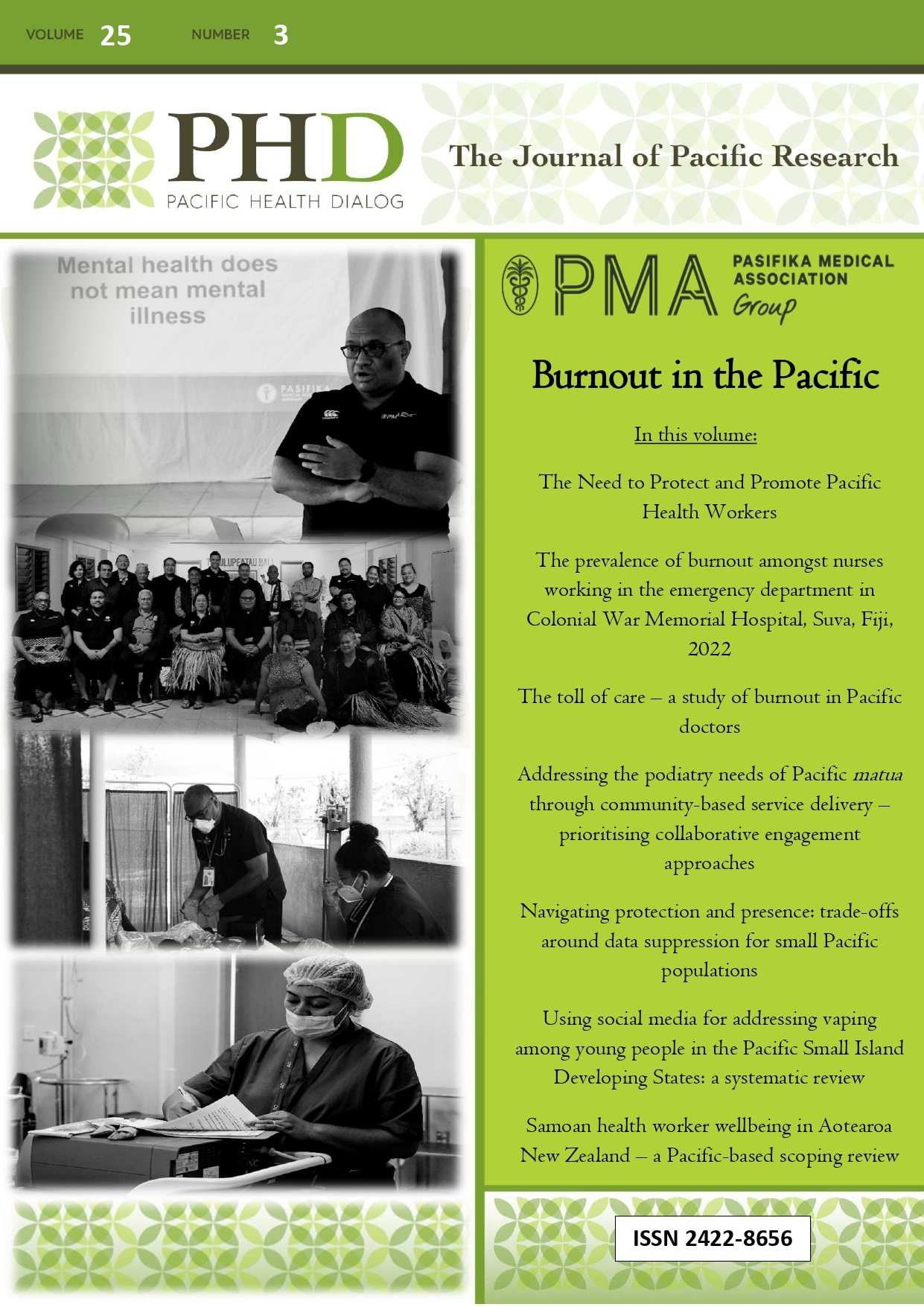The toll of care – a study of burnout in Pacific doctors
Main Article Content
Keywords
pacific, health workforce, burnout
Abstract
Objectives: This study aims to identify the level of burnout, risk factors and preventative strategies amongst Pacific doctors. The World Health Organization (WHO) The International Classification of Diseases, or the ICD-11 recognises burnout as an occupational phenomenon, but the lack of studies in Pacific healthcare settings may result in misalignment between experiences, risk factors and strategies to mitigate burnout. The COVID-19 pandemic has improved understanding of healthcare workers’ burnout caused by organisational, environmental or system issues, but more is needed to prevent, manage and recover from burnout.
Study design: The focus of the study design was real-life experiences and observations to explore multifaceted aspects of the phenomenon. The cross-sectional project used mixed methods to investigate burnout amongst doctors who were registered to practice in Pacific countries and territories. The Oldenberg Burnout Inventory (OLBI) was chosen as a psychometrically robust instrument that can be used to measure burnout and is based on the job demands-resources model. Additional participants were identified in leadership roles for the ability to further explore understanding of themes uncovered during the initial data collection and analysis.
Methods: An online survey was conducted using the OLBI, demographic variables and questions about strategies in the workplace in relation to healthcare burnout, and preferred self-care strategies. Focus group discussions and key informant interviews offered more in-depth and well-rounded understandings.
Results: Two hundred and sixty-eight people completed the online survey, from 14 different Pacific countries and territories. Using the OLBI, 60% of doctors reported high scores of burnout, 38.5% of doctors reported medium scores of burnout, with 1.5% reporting low scores. Focus group discussions with seven doctors working in Fiji and key informant interviews with three doctors in Fiji, Samoa and the Cook Islands offered more detailed experiences as well as in-depth knowledge of workforce policies and systems. Additional resources and good leadership is critical to support people experiencing burnout, including improving practices of employee recognition. Changes in the workplace culture, as well as in the community, was described as having potential to prevent, manage and recover from, healthcare worker burnout.
Discussion: Global comparisons do indicate high levels of burnout in the Pacific medical workforce, and significant impacts of the COVID-19 pandemic. Doctors shared current impacts and further risks associated with burnout experiences. As well as calling for a comprehensive framework in the Pacific for burnout, the doctors described some key strengths for future strategies to prevent, manage and treat burnout in Pacific settings.
Conclusion: Participants in this study called for an increased focus on burnout. Different conceptual frameworks demonstrate both burnout and stress are interconnected, and implementing tailored interventions are most effective in Pacific settings.
References
1. Balch CM, Freischlag JA, Shanafelt TD. Stress and burnout among surgeons: understanding and managing the syndrome and avoiding the adverse consequences. Arch Surg. 2009;144(4):371-6.
2. Wright T, Mughal F, Babatunde O, Dikomitis L, Mallen C, Helliwell T. Burnout among primary health-care professionals in low- and middle-income countries: systematic review and meta-analysis. Bulletin of the World Health Organisation. 2022;100.
3. Maunder RG, Heeney ND, Hunter JJ, Strudwick G, Jeffs LP, Ginty L, et al. Trends in burnout and psychological distress in hospital staff over 12 months of the COVID-19 pandemic: a prospective longitudinal survey. J Occup Med Toxicol. 2022;17(1):11.
4. Prakash P. Minister says over 800 nurses have resigned. FBC News. February 15, 2023. Accessed 25/06/2004 https://www.fbcnews.com.fj/news/minister-says-over-800-nurses-have-resigned/#:~:text=February%2015%2C%202023%201%3A30,speech%20in%20parliament%20this%20morning.
5. World Health Organization. The first 20 years of the journey towards the vision of Healthy Islands in the Pacific. 2015. Accessed 25/06/2024 https://www.who.int/publications/i/item/9789290617150
6. Maslach C, Jackson SE. The measurement of experienced burnout. Journal of Organizational Behavior. 1981;2(2):99-113.
7. De Hert S. Burnout in Healthcare Workers: Prevalence, Impact and Preventative Strategies. Local Reg Anesth. 2020;13:171-83.
8. Tu B, Yang Y, Cao Q, Wu G, Li X, Zhuang Q. Knowledge mapping of job burnout and satisfaction of medical staff and a cross-sectional investigation of county-level hospitals in Southern China. Heliyon. 2024;10(13).
9. Patel R, Huggard P, van Toledo A. Occupational Stress and Burnout among Surgeons in Fiji. Front Public Health. 2017;5:41.
10. Edú-Valsania S, Laguía A, Moriano JA. Burnout: A Review of Theory and Measurement. Int J Environ Res Public Health. 2022;19(3).


